#vespa mandarinia
Link
June 28, 2022
The Canadian Council on Invasive Species (CCIS) gave a short presentation of the top 10 invasive species already in Canada or that could come to Canada from south of our border and that we therefore should be on the alert for.
The top 10 invasive species were as follows:
Asian long-horned beetle, Anoplophora glabripennis
Spotted lanternfly, Lycorma delicatula
Asian giant hornet, Vespa mandarinia
Emerald ash borer, Agrilus planipennis
Hemlock woolly adelgid, Adelges tsugae
Brown marmorated stink bug, Halyomorpha halys
Dutch elm disease, Ophiostoma ulmi and Ophiostoma novo-ulmi
Japanese beetle, Popillia japonica
Spongy moth (also LDD moth; previously gypsy moth), Lymantria dispar dispar
Lily leaf beetle, Lilioceris lilii
I have definitely seen at least three of these species and/or the damage they have done, specifically 4, 8, and 9.
You can help by reporting these species through, for example, iNaturalist. CCIS has their own project on iNaturalist, titled “I Spy and Identify Invasives / Je vois, J’identifie les espèces envahissantes”, which you can join: https://www.inaturalist.org/projects/i-spy-and-identify-invasives-je-vois-j-identifie-les-especes-envahissantes. The CCIS also has a whole webpage on how and where to report: https://canadainvasives.ca/take-action/report/.
#wildflowers of southern ontario#invasive species#canada#Canadian Council on Invasive Species#inaturalist#Asian long-horned beetle#Anoplophora glabripennis#Spotted lanternfly#Lycorma delicatula#Asian giant hornet#Vespa mandarinia#Emerald ash borer#Agrilus planipennis#Hemlock woolly adelgid#Adelges tsugae#Brown marmorated stink bug#Halyomorpha halys#Dutch elm disease#Ophiostoma ulmi#Ophiostoma novo-ulmi#Japanese beetle#Popillia japonica#Spongy moth#LDD moth#Lymantria dispar#Lymantria dispar dispar#Lily leaf beetle#Lilioceris lilii
12 notes
·
View notes
Photo

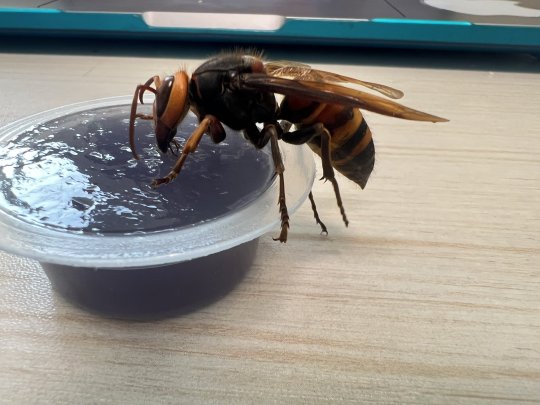
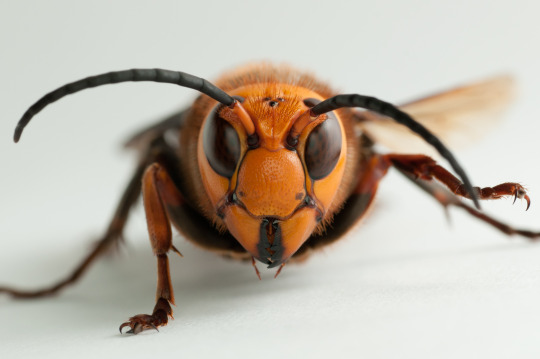

Vespa mandarinia aka the Asian giant hornet; and by its less affectionate Internet moniker “murder hornet”, is the world’s largest species of hornet! Native to temperate and tropical East Asia, South Asia, Mainland Southeast Asia, and parts of the Russian Far East.
First two photos courtesy of @aaiZveGu1X7nWwX (Twitter) who has a wide variety of photos and video clips of giant hornets he tends after. When isolated from a hive body and handled with care they aren’t the monster most make them out to be.
All hornets are wasps, but not all wasps are hornets. In the U.S., we have no native hornets. Our main hornet is the European hornet which was introduced into New York in 1840. It looks like a large yellowjacket—about ¾ to 1½ inches long—and nests in the ground or in hollow trees.
#vespa mandarinia#v. mandarinia#asian giant hornet#japanese giant hornet#murder hornet#hornet#wasp#insect#flying insect#invertebrate#wildlife#nature#photography
4 notes
·
View notes
Text

Vespa mandarinia
1 note
·
View note
Note
Hey I thought you might appreciate a heads up that the yellow-legged hornet (Vespa velutina) has been spotted in Savannah, Georgia. 😞
Nice. Well, not nice news. But glad that you thought of me. Thank you.

(For other people who have yet to fully embrace and explore their innate love of hornets, this Vespa velutina hornet is originally from Southeast Asia. This creature is closely related to Vespa mandarinia, the creature derisively referred to in the US as "murder hornet" or "Asian giant hornet", originally from South/East Asia, which is now apparently established near in the Salish Sea region near Bellingham, Vancouver, and Nanaimo.)
Here's a look at where the giant hornets now live in North America, along with the distribution of some other large hornets which might be mistaken as Vespa manadrinia/velutina:
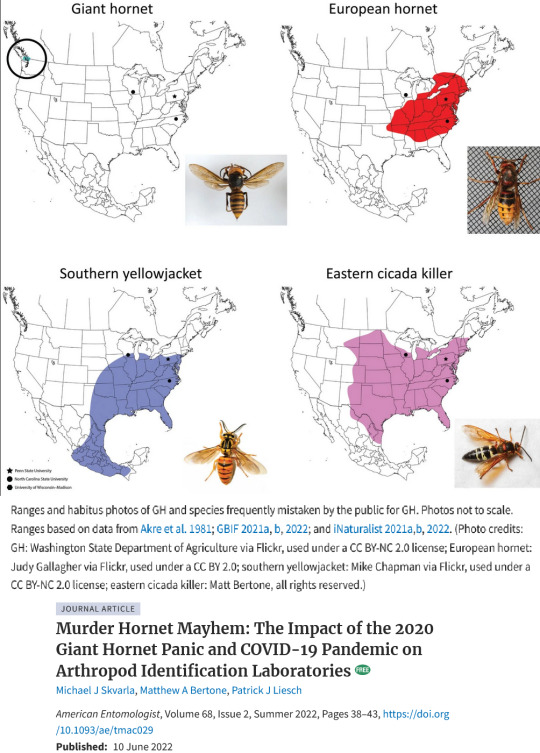
The map was originally published in 2022 in American Entomologist, displaying distribution range of (non-native) giant hornet; (non-native) European hornet; (native) southern yellowjacket; and (native) eastern cicada killer. The article also identifies a few few other species which might be mistaken for "murder hornets": great golden digger wasp, bald-faced hornet, German yellowjacket, red-legged cannibal fly, and pigeon horntail. (Available to read for free online; article title in the source/caption beneath the map.)
I've had many memorable encounters with large (native) bald-faced hornets in dense cedar-hemlock rainforest-y places. And coincidentally, the Pacific Northwest is also now apparently the North American home/homebase of Vespa mandarinia. So here are some other PNW wasps/hornets in comparison, from Oregon State University Extension Catalog (2022):
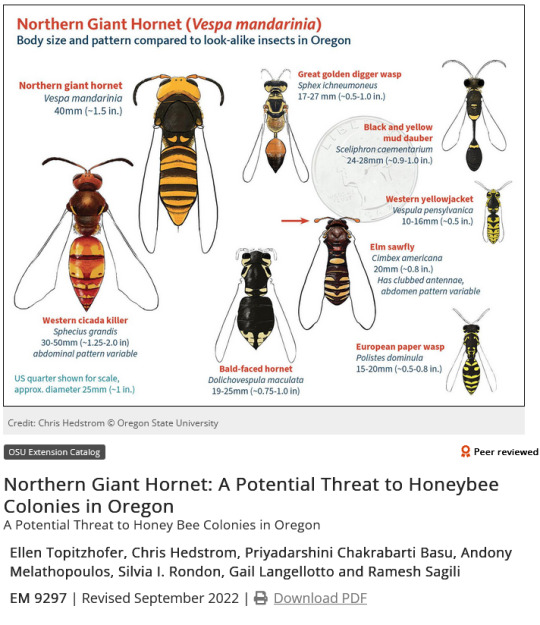
From 2020 research on potential dispersal of Vespa mandarinia over a couple of decades (not necessarily a good or realistic representation, not inevitable, kinda just "potential"):

Apparently Vespa mandarinia haven't yet been encountered outside of the general Vancouver area during targeted samples:
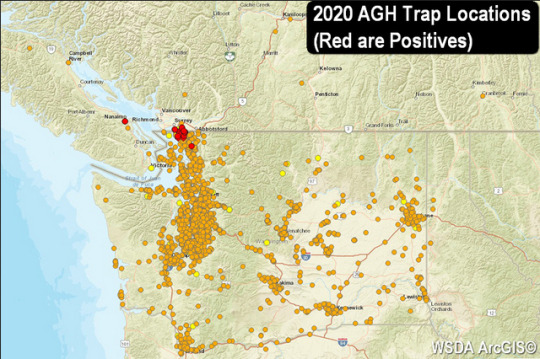
I know that you too are fond of wasps/hornets, and are aware of their popular demonization, the way that they're feared, etc. In July 2022, the Entomological Society of America put out an online resource thing that explains why they don't like the name "Asian giant hornet" for Vespa mandarinia and Vespa velutina, instead adopting "northern giant hornet" and "yellow-legged hornet" (which you called the creature, too!) because of the racialized/xenophobic implications. ("Northern Giant Hornet Common Name Toolkit" available at: entsoc.org/publications/common-names/northern-giant-hornet) They say: '"Murder hornet" unnecessarily invokes fear and violence, which impede accurate public understanding of the insect and its biology and behavior. While "Asian" on its own is a neutral descriptor, its association with a pest insect that inspires fear and is targeted for eradication may bolster anti-Asian sentiment in some people - at a time when hate crimes and discrimination against people of Asian descent in the United States are on the rise.'
Which, for me, brings to mind this recent book from Jeannie Shinozuka:

From the publisher's blurb: 'In the late nineteenth century, increasing traffic of transpacific plants, insects, and peoples raised fears of a “biological yellow peril” [...]. Over the next fifty years, these crossings transformed conceptions of race and migration, played a central role in the establishment of the US empire and its government agencies, and shaped the fields of horticulture, invasion biology, entomology, and plant pathology. [...] Shinozuka uncovers the emergence of biological nativism that fueled American imperialism and spurred anti-Asian racism that remains with us today. [...] She shows how the [...] panic about foreign species created a linguistic and conceptual arsenal for anti-immigration movements that flourished in the early twentieth century [...] that defined groups as bio-invasions to be regulated—or annihilated.'
A lot going on at that time with insects, empire, and xenophobia. In the 1890s, the British Empire was desperately searching for a way to halt malaria, and mosquitoes had just been discovered as vectors of malaria. And from Nobel prize podium lectures to popular media newspapers and academic journals, there was all kinds of talk about how "bacteria/viruses/insects are the greatest enemy of the Empire" and whatever. The US was also expanding in the Caribbean, Central America, Pacific islands towards East Asia, etc. Tropical plantations were proliferating, not just in Dutch Java or British India, but also in US administered Central America. And so insects were perceived not just as a threat to the human body of the British soldier or American administrator; insects were also a threat to profits, as insect pests threatened monoculture plantations and agriculture.
That same time period saw the US invasion of the Philippines and exports of products from the islands; the US annexation of Hawai'i, and elevating rivalry with Japan; the 1882 passage of the notorious Chinese Exclusion Act; US control of Cuba and Puerto Rico; expansion of US fruit corporations in Central America and US sugarcane plantations in Cuba/Hawai'i, where insect pests threatened plantation profits; the advent of "Yellow Peril" tropes and fear of invasion in science fiction literature; the detaining of half a million (mostly Chinese) people at the medical quarantine processing center that the US Public Health Service operated at Angel Island in San Francisco; and US insect extermination projects, mosquito control campaigns, and medical policing of local people in Cuba and the Panama Canal Zone (where US authorities detained local people for medical testing).
A lot to consider.
58 notes
·
View notes
Text
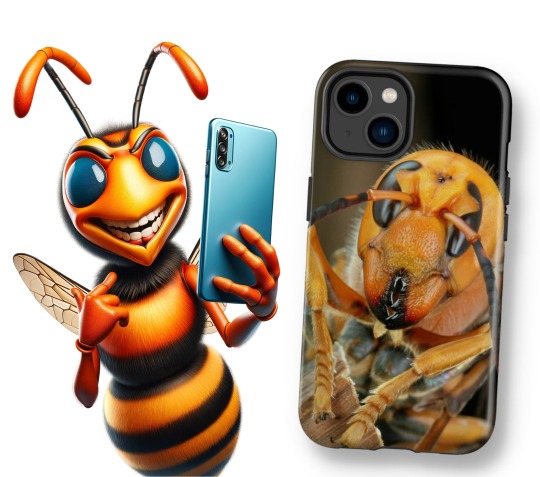
SINOBUG entomological phone cases - for iPhone & Samsung models with slim, tough, and soft case options on REDBUBBLE (plus lots more)
Asian Giant Hornet (Vespa mandarinia, Vespidae)
Pu'er, Yunnan, China
https://redbubble.com/shop/ap/153052552
Full store: http://itchydogimages.redbubble.com
#insect#itchydogimages#sinobug#entomology#photography#macro#yunnan#china#hornet#Hymenoptera#Vespidae#redbubble#redbubble shop#redbubble artist#merch#phone cases
9 notes
·
View notes
Text
The "Murder Hornet’s" Invasive Cousin Is Spotted in the USA

A social wasp from southeast Asia (and plaguing Europe for a decade), the yellow-legged hornets’ egg-shaped paper nests are commonly found in trees and house an average of 6,000 workers. To feed these workers, the hornets hunt insects... which is bad news for everyone:
This species prefers to eat honeybees.
Add the larger size of the yellow-legged hornet to their strength and thick exoskeleton, and you get a bad outcome for bees when these hornets attack.
"Vespa velutina are 'true hornets' and are exceptional predators," according to Clemson University's Land-Grant Press.
The vespa genus includes both this yellow-legged hornet and the northern giant hornet, Vespa mandarinia (aka the Asian giant hornet, or, more frighteningly, "murder hornet," for the deadly and violent havoc they wreak on bee colonies).
They're distinct from North America's wasps. Common U.S. insects such as yellowjackets and "bald-faced hornets" are sometimes called hornets, but they're not in the same genus as the Asian hornets. Crucially, those homegrown bugs don't wage gruesome warfare on bee colonies.
Most hornets prey on other insects’ larvae, and many species target nests of other social bees and wasps. The yellow-legged hornet descends upon a bee nest, kills off the workers defending the nest, and feasts on the larvae - true devastation of an entire local honeybee existence.
Note: Please don't go killing insects that look like this bad boy - native wasps and "hornets" might appear the same, but they can help control this invasive species. Report sightings instead.
More info in the NPR story: X
Screenshot from the Popular Mechanics story: X
Georgia's press release, including link to report sightings: X
13 notes
·
View notes
Photo

Giant Hornet
With the Summer comes the insects, and the master of all, the giant hornet (Vespa-mandarinia). Extended, this one was over 55mm long.
25 notes
·
View notes
Text

Was beyond excited to receive these high quality stickers and original prints - finally worked up a way to display! If you similarly love this artists style and want to get your hands on some for yourself check out Maenad Press store on Society 6 and Etsy or follow @mx-vespa-mandarinia
4 notes
·
View notes
Text

[art of a non-binary person sitting on the bed with a panel on the right describing their tattoos.
Inarius "Ari" Lane. They/them.
Conium maculatum. AKA "poison hemlock" causes paralysis, loss of speech, inhibited respiratory function, and death.
Vespa mandarinia. AKA "Asian Giant Hornet" causes great pain, inflammation, allergic reaction, and sometimes death.
Latrodectus hesperus. AKA "western black widow spider" causes muscle rigidity, perspiration, and nausea.
Epicauta vittata. AKA "striped blister beetle" causes burns, blisters, renal damage, gastrointestinal damage, urinary tract damage, abdominal pain, and rarely, prolonged erections.
Convallaria majalis. AKA "lily of the valley" causes abdominal pain, nausea, vomiting, and irregular heartbeats.
Ophiophagus hannah. AKA "king cobra" causes severe pain, blurred vision, vertigo, drowsiness, paralysis, and if severe enough, coma, and death.]
Inarius Lane is the main character in my upcoming horror graphic novel! It will be released chapter-by-chapter, so stay tuned!
Please follow SCMK Art so you can be the first to read it!
Close-ups are under the read more!

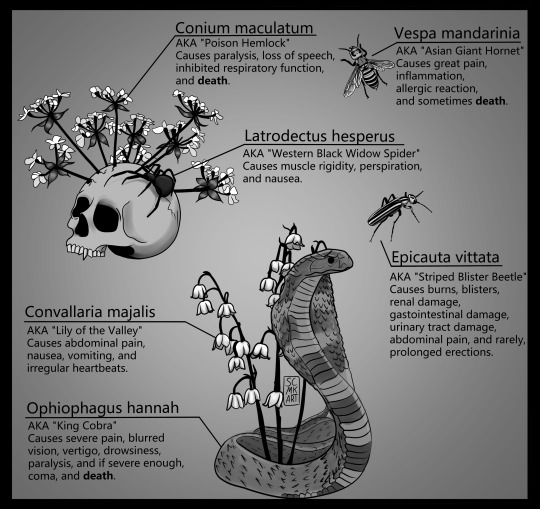
#scmkart#scmk art#oc artist#graphic novel#horror#nonbinary#digital art#digital artist#artists on tumblr#inarius lane#tw snakes#tw insects#tw spiders
5 notes
·
View notes
Text
Are Insects Pests? On Loving the Unloved
(Originally posted at my blog at https://rebeccalexa.com/are-insects-pests-on-loving-the-unloved/)
I do a lot of internet searches in the process of writing my articles and books, putting together class materials, and so forth. Sometimes the subject of insects comes up, and that often includes researching individual species. What gets me is how often some of the first search results won’t be informational sites, but those dedicated to labeling insects “pests” and eradicating them. I get that some species are potentially more problematic when found in or around someone’s home; cockroaches and bedbugs come to immediate mind. But again and again, regardless of what sorts of insects I was searching for, many times the results included exterminator sites.
The fact that so many of the highest search results are dedicated to killing insects suggests there’s a lot of demand for such services and products. It makes me sad, honestly, because we’re right in the middle of an insect apocalypse. There’s already a lot of apathy about conserving invertebrates in general, and “bugs” in particular; many folks simply don’t get why it’s so important to protect the creepy-crawlies of the world. And when it’s common for any insect found in a house to be routinely smashed and discarded without a second thought, regardless of species, “save the bugs!” may seem like an ineffective rallying call indeed.
But let’s look at a few of those search results first, shall we?
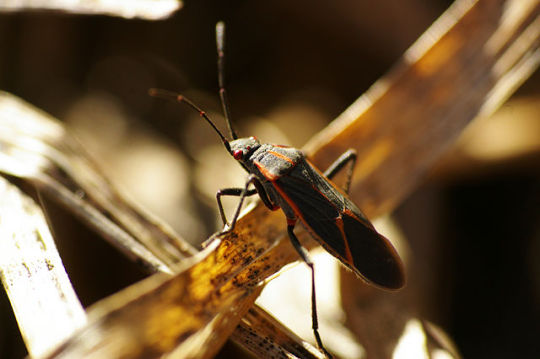
My favorite search engine is Ecosia; I have it set up as my default search engine in my browser. They use the profits from ads to plant trees, and as of this writing they’ve planted over 150 million trees. I use Google as a backup, if Ecosia’s results aren’t getting me what I want.
The other day I wanted to know about wasp species in Washington. So I searched Ecosia for “Washington wasp species”, and the ninth result on the first page was a pest control site:

Google was even worse. It took scrolling down only to the third result on the first page to end up with a pest control site:

Okay, so wasps don’t exactly have a great P.R. team., and media furor over the Asian giant hornet (Vespa mandarinia) didn’t help the results become any friendlier, either. I figured I’d try a few more very general searches just to see how long it took to hit a pest control site or other site that talked about eradicating the insects I was searching for:
True Bugs: Ecosia 8th on page 1, Google 1st on page 2
Bees: Ecosia 3rd on page 1, Google 3rd on page 1
Grasshoppers: Ecosia 2nd on page 2, Google 5th on page 1 (this was without filtering out things like the Grasshoppers Minor League Baseball team)
Crickets: Ecosia 3rd on page 1, Google 3rd on page 1
Weevils: Ecosia 1st on page 1, Google 2nd on page 1 (never mind that the vast majority of weevils are harmless to us and our food.)
Beetles: Ecosia 1st on page 2, 4th on page 1
Oregon Beetle Species: Ecosia 1st on page 2, Google 4th on page 1
Unsurprisingly when I searched for “fireflies” and “butterflies”, I went back several pages on both search engines and didn’t find anyone advocating for the mass slaughter of these beloved insects. You’d think bees would get the same treatment what with all the “save the bees” campaigns over the past few years, but the 3rd result from both search engines was from a site called “Pest World for Kids”, run by the National Pest Management Association. Really?
Okay, so admittedly this was definitely NOT a scientific study. And I recognize there are a number of factors determining search results, SEO, etc. like how large and popular a given site is, age of the site, backlinks, etc. Still, given how high up in the ranking sites treating insects as pests were, and how many of the recommended related searches had to do with things like whether the insects being searched for would bite, or how to get rid of them, that suggests a lot of people are searching for how to go to war with insects rather than learning about them as unique beings.
On the bright side, most of the results were site that genuinely wanted to educate people about various insects on their own merits. So it’s not as though everything is terrible (unless you’re a weevil, for whom almost all the top search results were pest-related.) Whether those sites got as many genuine clicks as the pest-related ones, I couldn’t tell you. But it was nice to see them anyway.

Maybe I’m in the minority when I wish that people would spend less time trying to eradicate insects, and more time learning about them. It’s just that most folks seem to ignore them unless they become a perceived nuisance. I’ve had to deal with problem insects before–narcissus bulb flies (Merodon equestris) in the garden, pantry moths (Plodia interpunctella) in the flour, etc. And yes, sometimes that involves smushing them on sight, especially in the case of a non-native species.
But I also try to make an effort to learn about even these species. It’s not just to learn how to get rid of them, but to find out more about their adaptations and habits, where they came from, what makes them different from other insects–what makes the species what it is. It’s curiosity that drives me, and I find myself appreciating their ability to find a niche, even if it’s one that’s at odds with my own interests.
It also makes me really think about whether I really need to persecute a particular species, and how that affects my attitudes toward not just insects, but other living beings. When I stop and consider my actions toward another species, it breaks the conditioning that so many of us have to just see nature as something to serve us–only good if it does what we want, and bad if it goes against our wants and needs. And I find myself being able to make a more informed decision that, at times, may be summed up as “leave well enough alone.”
Hence the nest of black-tailed bumblebees (Bombus melanopygus) that has spent multiple years buzzing about the entryway of my garage. Hence the common house spiders (Parasteatoda tepidariorum) that are allowed space in the corners and window-wells of my home to help control flies that may buzz their way in on warm days. Hence the cabbage looper caterpillars (Trichoplusia ni) who get a reprieve in the garden, even though they go after cruciferous vegetables, because they never take everything, and they’re important food for other species. Some would easily justify my killing these and many others, simply for being mildly inconvenient, or just being in the wrong place at the wrong time.
But I prefer to coexist whenever possible, and to look beyond the “pest” label as well.
Did you enjoy this post? Consider taking one of my online foraging and natural history classes, checking out my other articles, or picking up a paperback or ebook I’ve written! You can even buy me a coffee here!
#long post#insects#invertebrates#bugs#arthropods#science#nature#scicomm#science communication#gardening#ecology#environment#environmentalism#pollinators#animals#wildlife#conservation#pests#extinction
478 notes
·
View notes
Text
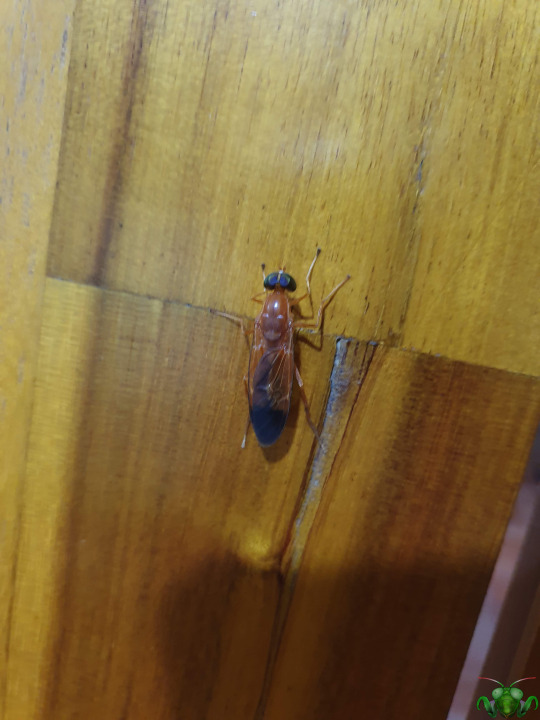







Gold Compost Soldier Fly - Ptecticus aurifer
Though separated on another continent by an expanse of ocean, this specie is quite similar in appearance to the North American specie that I've seen. This Fly doesn't have a common name, but I've given it one for this blog which draws from its specie name. Aurifer refers to gold (aurum, which is likely a reference to its body) hence the name 'Gold Compost Soldier Fly'. Comparing this insect to the Compost Soldier Fly from Ontario highlights this observation: same body style and color, same gait, same wing posture at rest, same green eye color, and same shortened antennae on a white face. The side view of Picture 4 also shows faint striping along the abdomen, just like its North American relative. However, the more eagle-eyed among you may also noticed a dark patch on the underside of the abdomen, which is something that our Compost Soldier Fly lacks. Furthermore. even at a mere glance the biggest difference in appearance is that this Fly's wings are darkened towards the apex, traveling along the wing's posterior margin (the lower edge). This wing pattern is much easier to see during mating as the wings move to the side (preventing damage and obstructions) when one Fly climbs the other.
Here with the wings folded, it gives the impression of a prominent patch of black on the wing. How might such a difference be purposed? On the assumption that this Soldier Fly behaves in a similar fashion to the Ptecticus species of Ontario, it likely mimics the behavior and flight of Wasps in order to avoid predation. The addition of darkened wing margins may aid in the mimicry of parasitic Wasps that such as the Braconids and Ichneumonids of Asia. No one and no predator would mistaken this Fly for the Asian Giant Hornet (Vespa mandarinia; sometimes referred to 'Murder Hornet', which is a bit much), but there is a chance that it could pass for something like Disophrys maculifera. Though a parasitic Wasp, it is a Wasp nonetheless and is likely to be left alone. If that's the case, this Fly may have some luck as well, especially because it lacks defenses beyond controlled flight. If mimicry is successful, then it has every advantage it needs to search for composting matter to mop up, or for fermenting fruit to place its eggs...that is until other Wasps arrive to feast at the same food sources. Even if it's a mimic, it is unwise to disturb a hungry Wasp when nectar-filled fruit is the prize!
Pictures were taken on November 18, 2019 in Vietnam with a Google Pixel.
#jonny's insect catalogue#insect#fly#gold compost soldier fly#ptecticus aurifer#soldier fly#asia insect#vietnam#november2019#2019#nature#entomology#invertebrates
2 notes
·
View notes
Text
File: BEEHIVE
SCP-AQC
Code Name: The Hive Boy
Object Class: Euclid
Special Containment Procedures: A squad of Mobile Task Force Lambda-12 "Pest Control" is responsible for guarding SCP-AQC. SCP-AQC is contained at Site-AF within a 32x32 meter room with an air filtration system that prevents any SCP-AQC-1 instances from escaping. The room is large enough to allow over a hundred SCP-AQC-1 hives to exist at any time. As requested by SCP-AQC, the corpse of a single cow is to be introduced into SCP-AQC's containment cell so that the SCP-AQC-1 instances can feed.
SCP-AQC relies on SCP-AQC-1 instances to care for, heal, and feed him so Foundation staff are not required to care for him. SCP-AQC has not requested any new clothes, furniture, toys, or any kind of accommodation, so Foundation staff are not required to bring any. So long as the SCP-AQC-1 instances are well fed and cared for, so is SCP-AQC. Testing must be approved by at least one Level 3 Foundation clearance staff member, there are no exceptions.
Description: SCP-AQC is an undead boy of an unknown age thought its suspected that be somewhere between the ages of 11 and 13. SCP-AQC even while he was alive had the anomalous ability to control and communicate with a wide variety of wasps and bees. The ones that he seems to have the deepest connection with is the Vespa Mandarinia species. Thought regardless of species they are known as SCP-AQC-1 instances. For whatever reason after speaking with them they become completely loyal to SCP-AQC. Furthermore, they don't mind the presence of other SCP-AQC-1 instances regardless of species.
SCP-AQC died due to decapitation by [data expunged], by the time the Foundation found him he was nothing but bones. SCP-AQC seems to have bits of his flesh in his neck, where he was decapitated, the rest is held together by beeswax. SCP-AQC is still clinically dead but despite that he talks and movies around as if he is alive. Scans have shown that his brain is fresh but not active and his heart has blood flowing through it, but it doesn't beat. He seems to be in a sort of state where he is not fully dead but not fully alive either, how this works or is even possible is unknown.
Even before SCP-AQC died, he had a negative view on humans and though he treated most with minor kindness or indifference. However, after SCP-AQC died he became increasingly furious at humans and protective of his SCP-AQC-1 instances. SCP-AQC will often allow or even order his SCP-AQC-1 instances to attack any human in sight and feed on their flesh.
SCP-AQC-1 instances do worry about themselves and their hives; however, SCP-AQC is always their top priority. Should SCP-AQC ever receive a wound of any kind SCP-AQC-1 instances will intervene. If the wound is minor, then they will use beeswax to stich it, allowing it to slowly heal on its own. If the wound is severed then they will take chucks of meat and place, it into the wound until it is full and attach it all together with beeswax. About a month later the wound thought still made of meat chucks and beeswax will resemble skin. How any of this works is entirely unknown.
SCP-AQC was discovered in May 1991 when reports of Hornets invading the house of [data expunged] was reported by the residence of [data expunged]. Originally this was believed to be just an out-of-control wasp infestation, so the local pest control was entrusted to deal with the situation. However, after taking care of the wasps on the outside of the house, they moved into the house but never came out. Furthermore, it was reported that inside the house there were sightings of a child moving around. The last straw was when it was confirmed that the wasps surrounding the house was made up of different species especially species that were known to be hostile to one another.
With the information given Mobile Task Force Lambda-12 "Pest Control" moved in with Cryo Blasters. However, by the time they did so SCP-AQC-1 instances started swarming and attacking the town forcing Foundation agents to evacuate the area quickly. Thankfully MTF Lambda-12 was able to subdue a majority of SCP-AQC-1 instances. Due to the massive culling SCP-AQC himself showed up and agreed to surrender in exchange for the Foundation sparing his SCP-AQC-1 instances. As for surviving civilians the cover story was that the swarm was caused by a massive wasp migration due to changing seasons. Since they saw the SCP-AQC-1 instances and not SCP-AQC himself they believed it and thus no amnestic treatment was required.
It was thanks to SCP-AQC's surrender that the Foundation was able to transport him to Site-AF so easily and how testing with SCP-AQC goes so well. However, SCP-AQC still views humanity with contempt and clearly secretly plans to one day escape so that his SCP-AQC-1 instances can be free. It is for this reason that SCP-AQC was not recommended for Mobile Task Force Alpha-9 "Last Hope" recruitment.
.
SCP: Horror Movie Files Hub
#DZtheNerd#SCP: Horror Movie Files#SCP Foundation#SCP Fanfiction#SCP AU#SCP#horror world of junji ito#junji ito
2 notes
·
View notes
Photo


W A S P THING--
Specifically based off of a “Vespa mandarinia”
#my art#my oc babs#Amos#William#William gets fucking BITTEN by a big ass bug#he'll be fine lmao#bugs
13 notes
·
View notes
Text

[OC REF] Ivester
One of my favorite designs I've made recently!!!
Name/ Title: Ivester. See above for each head's name.
Pronouns: He/ They/ It
Age: Unknown, Older Adult
Species: Patchwork Jester Monster
Height: 7'4"
Voice Type: Each head has it's own voice, however if one head speaks for the entire body all their voices will emanate from it. Moon appears to be the dominant speaker for all the heads.
Moon's voice: Baritonous Older Masculine
Stout's Voice: Mid Younger masculine
Score's Voice: High Squeaky masculine
Card's Voice: Androgynous hushed whisper
Personalities:
-Moon: Forward, aggressive, snarky, playful, greedy, dominate, smooth, and a bully.
-Stout: Playful, Cheery, Relaxed, Talks a lot, and apathetic.
-Score: Cheeky, Snarky, kluts, obnoxious, silly, and distracted.
-Card: Quiet, spooky, ominous, foreboding, creepy, and helpful.
Other Information:
-The heads on the neck can rotate to whoever is dominantly talking.
-Most of the time the body is controlled by one head, however fights for the control of the body can happen.
-They have a uncomfortable obsession with bugs... and are almost certainly infested with the creatures. Hence the name "Ivester"... Infested Jester. The bugs you'll commonly see crawling around on them are "Mealworms & Millipedes" - Moons fav, "Vespa mandarinia" - Stout's fav, "Roaches & Carrion Flies" - Score's fav, "Scorpions & Carrion Beetles" - Card's Fav.
───⋘✦═♜═✦⋙───
╔═════════════════════════╗
Art, Concepts, & Characters are © to ConsciousColony
<Terms of Use & Service>
╚═════════════════════════╝
#original character art#drawing#original character#oc#originalcharacter#original art#orignal character#creepy#original work#clown art#clown#clown character#clown oc#monster#monster oc#monster character#multiple heads#horror#horror character#jester#jester oc#jester character#monster jester#muscular character
7 notes
·
View notes
Note
i've got plenty of bugs i remember from my wrigglerhood! hornets,are one of my favorites. however,if i were to be more specific as there are many hornet species- vespa mandarinia (asian giant hornet) is my favorite. take a look,this one is a female of its soecies- a queen. [i hand avonis the hornet- she is kept in a clear glass box with small holes for air.]
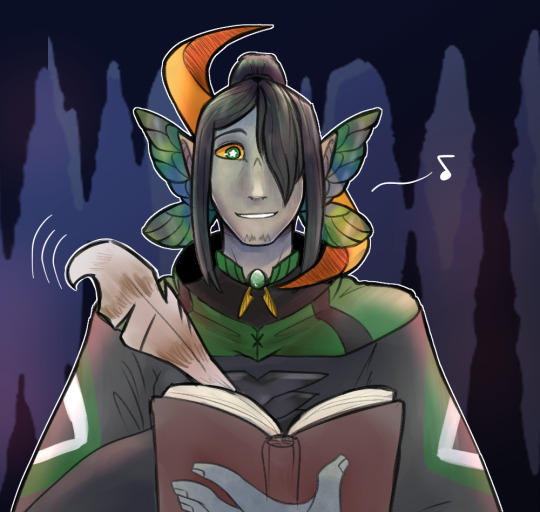
"✒ Fascinating! A queen? Oh, very large, I do indeed enjoy the coloration and stripes."
He leans in to observe more after writing some notes and doing some sketches.
"✒ Salutations, Your Highness."
4 notes
·
View notes
